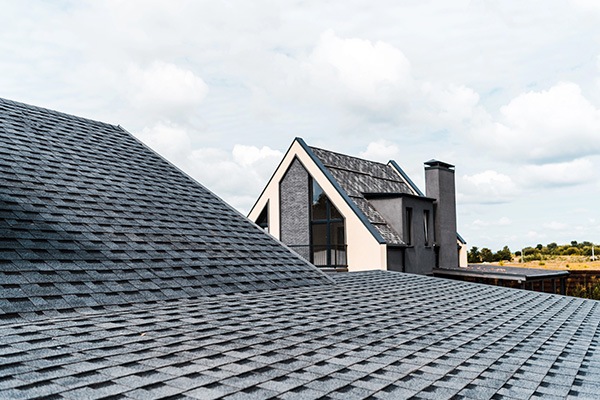Roofing shingles are a significant part of your house that affects the look, feel, sturdiness, and value of your home. To settle on the appropriate type of roof shingles and secure long-lasting protection for your property, it’s important to consider factors like your local climate, architectural style, budget, and maintenance requirements.
This guide will take you through the various roof shingle types and their benefits, providing insights into their ideal applications to help you make a well-informed decision.
Asphalt Shingles
Asphalt shingles are among the most popular roofing materials due to their affordability and versatility. There are three main forms:
- Three-Tab Shingles: These are the most basic and economical option. They feature a uniform shape and size, making them a straightforward choice for homeowners on a budget.
- Architectural Shingles: Also known as dimensional shingles, these have a thicker, multi-layered design that adds depth and character to the roof. They offer better durability and a more attractive appearance compared to three-tab shingles.
- Premium Shingles: Premium shingles provide the highest quality and aesthetic appeal, often mimicking the look of natural materials like slate or wood while offering the benefits of asphalt.
One of the primary advantages of asphalt shingles is their cost-effectiveness. They are easy to install, which can reduce labor costs, and they come in a wide range of styles and colors to suit various home designs.
Asphalt shingles are also relatively durable, with a lifespan of 15 to 30 years. They perform well in a variety of climates, though they may have a shorter lifespan in areas with extreme temperature fluctuations or high UV exposure.
Wood Shingles
Wooden roof shingles are typically made from cedar, redwood, or pine. They are precisely cut and tapered, giving them a smooth and uniform appearance. Wood shingles provide a rustic look that is hard to replicate with other materials.
Their natural charm makes them a popular choice for homes with traditional or historic architectural styles. They offer excellent insulation properties, helping to keep homes cooler in summer and warmer in winter. Wood is also a renewable resource, making wood shingles an environmentally friendly option.
However, wood shingles require regular maintenance to prevent issues like mold, rot, and insect damage. They need to be treated with preservatives and inspected periodically to ensure their longevity.
When properly maintained, wood shingles can last between 20 and 40 years. They are best suited for dry climates, as excessive moisture can accelerate deterioration.
Metal Shingles
Metal shingles are a popular roofing choice due to their durability and modern aesthetic. They are made of various materials, including aluminum, steel, and copper. Aluminum shingles are lightweight and very anti-rust, making them ideal for coastal regions where saltwater corrosion is a concern.
Steel shingles are known for their strength and can be coated with zinc or an alloy to prevent rust and corrosion, making them appropriate for areas with harsh weather conditions. Copper shingles, although more expensive, provide a distinctive and timeless look that ages beautifully, developing a patina that can enhance a home’s curb appeal.
One of the most significant benefits of metal shingles is their longevity. Metal roofs can survive anywhere from 40 years to 70 years, outlasting conventional asphalt shingles by a long mile. This makes them a cost-effective option that’s here to stay for the long haul.
Metal shingles are also energy efficient, as they reflect heat that is solar-radiant, which can reduce cooling costs in the summer. Additionally, metal roofs are highly fire resistant, providing an added layer of safety for your home.
When it comes to durability, metal shingles stand out. They can take extreme weather conditions, including heavy snow, hail, and high winds. However, installation requires expertise to ensure proper alignment and secure fastening, which might increase the initial installation cost.
Slate Shingles
Slate shingles are often considered the pinnacle of roof materials owing to their natural beauty and durability. There are two main types: natural slate and synthetic slate.
Natural slate is quarried stone, cut into thin, uniform tiles. Each piece has a unique texture and color, contributing to its elegant appearance.
Synthetic slate is made from engineered materials like rubber or plastic, designed to copy the look of natural slate while being lighter and more affordable.
Slate shingles have almost unmatched durability. Natural slate roofs can last over a century with proper care, an excellent investment for long-term homeowners. Slate shingles require low maintenance, as they are resistant to mold, mildew, and insect damage.
Also, the elegant appearance of slate adds a touch of sophistication to any home, and its wide range of natural colors and textures allows for customization to match various architectural styles.
While the durability and beauty of slate are significant advantages, there are cost considerations to keep in mind. Natural slate is one of the most expensive roofing materials, both in terms of material cost and installation. The weight of slate shingles also requires a robust roof structure, which may necessitate additional reinforcement.
Slate shingles are fitting in climates that do not experience extreme temperature fluctuations. They perform well in areas with moderate weather conditions, where their longevity and low maintenance needs can be fully appreciated.
Clay and Concrete Shingles
Clay and concrete shingles offer a unique combination of durability and visual appeal for many home designs. Clay shingles are made from natural clay baked in a kiln, while concrete shingles are composed of a mixture of cement, sand, and water. Both types are available in a range of shapes, sizes, and colors, allowing for versatile design options.
One of the primary benefits of clay and concrete shingles is their longevity. These materials can last 50 to 100 years, a fantastic long-term roofing solution. They are highly resistant to fire and insects, adding an extra layer of defense for your household.
Additionally, clay and concrete shingles are energy efficient; they have natural thermal properties that help regulate indoor temperatures, reducing heating and cooling costs. They have the ability to endure harsh weather conditions as well, including heavy rains, strong winds, and even hail.
However, their weight is a significant consideration. Both clay and concrete shingles are heavier than other roofing materials, which means the roof structure must be able to support the additional load. This might require structural reinforcement, adding to the total cost.
Clay and concrete shingles are ideal for climates with hot, dry weather, where their thermal properties are wholly utilized. They are also suitable for regions that are prone to wildfires, given their excellent fire resistance.
Solar Shingles
Solar shingles are a modern advancement in roofing technology combining the functions of a traditional roof with solar power generation. These shingles are made to look just like conventional roofing materials while incorporating solar cells that capture sunlight and convert it into electricity. This integration allows homeowners to harness solar energy all without bulky solar panels.
The primary benefit of solar shingles is energy production. By generating electricity from sunlight, they can significantly reduce your reliance on grid power, leading to lower energy bills and greater energy independence.
Solar shingles are also environmentally friendly, as they produce clean, renewable energy and reduce greenhouse gas emissions. Additionally, solar shingles have a modern appearance, blending seamlessly with your existing roof to maintain the aesthetics of your home.
In terms of durability and lifespan, solar shingles are designed to withstand harsh outdoor elements, rain or shine. They usually last 20 to 30 years, similar to conventional roofing materials, though their efficiency may degrade slightly over time.
Cost and installation-wise, they are more expensive than traditional shingles due to the technology involved. Installation requires specialized expertise, which can add to the initial cost. However, potential savings on energy bills and incentives such as tax credits can offset the higher upfront investment.
Solar shingles are perfect in sunny climates, where they can maximize energy production. They are a great choice for homeowners wanting to invest in renewable energy solutions while maintaining the look of their roofs.
Composite Shingles
Composite shingles are made from a variety of materials, including rubber, plastic, and polymer blends. These materials are engineered to imitate more traditional roofing materials such as wood, slate, or tile, providing an affordable and versatile alternative.
One of the main benefits of composite shingles is their durability. They can withstand cracking, warping, and other forms of damage that can affect natural materials. Additionally, they offer a wide variety of styles and colors, allowing homeowners to achieve the desired aesthetic without the limitations of natural materials.
As composite shingles are very hardy against weather and impact, a reliable choice for areas prone to severe climatological conditions. They are also lightweight, which means they can be installed on most roof structures without the need for additional reinforcement.
Composite shingles normally last 30 to 50 years, depending on the quality of the materials and the installation. They require minimal upkeep, as they do not suffer from the typical bug and fungal deterioration that can affect natural materials.
Get Top-Quality Shingles Fitted by Harvey’s Five Star Roofing Today
Choosing the right type of roof shingles is a key decision that impacts your home’s appearance, energy efficiency, and overall durability. Whether you opt for the affordability of asphalt, the natural beauty of wood, the longevity of metal, or the elegance of slate, we’ve got your back.
Alternatively, if you were looking for the resilience of clay shingles; the energy efficiency of solar shingles; or the versatility of composite shingles, Harvey’s Five Star Roofing can help too with our residential roofing services.
We always go the extra mile to account for the specific climate, budget, and architectural style of your home. Give us a ring today at 712-832-3660 and we’ll get the ball rolling with a free roofing inspection.









